Panayiotis Tetsis: Greece in Full Color
From bustling street markets to Hydra’s...

Friendship, collaboration, and a sense of purpose shaped the culture of 20th-century Greece. A quest for Greekness in the wake of the Asia Minor Catastrophe inspired a creative interchange throughout the arts, while uniting tradition with contemporary currents. Music brought everything together – poetry, theater, dance, painting. From folk songs to the symphonies of Mitropoulos, and from the rebetiko of Vamvakaris to Xenakis’ avant-garde compositions, 20th-century Greek music had an extraordinary range.
The story takes shape at the exhibition “It’s Time We Listened,” curated by Erato Koutsoudaki for the Institute of Greek Music Heritage. The Ghika Gallery of the Benaki Museum makes an ideal setting; this comprehensive overview of 20th-century Greek culture introduces nearly 200 creators spanning all the arts, from the interwar era to the dictatorship.
The exhibition highlights the 11 composers already in residence at the Ghika Gallery, each represented with a video display in a green stand. “In addition to sharing their music, we hoped to give a sense of who the composer was as a person – their voice, gestures, and personality. We sometimes share recordings from the era in which the pieces were written, but we’ve also used contemporary interpretations, like Vamvakaris’ Frangosyriani by Locomondo; some pieces run deep in our veins. The connections among the composers and also with poets, painters, and creators in the dramatic arts is also key to the larger story.”
You’ll see green dots on the floor with observations in the composers’ own words. These reveal surprising connections and influences. “The visitor has the freedom to connect the story in an unrestricted, personal way,” says Koutsoudaki. Using an app to scan the faces of creators (marked green), for example the choreographer Manou (of the Helliniko Choreodrama) or the poet Ritsos, we learn more: stories, songs, or related video content, such as watching the great painter Tsarouchis – devoted to rebetiko – being invited by Tsitsanis to dance the zebeikiko on stage at “Charama.”


The ground floor display dedicated to Mitropoulos serves as the foundation for the exhibition. He was a fundamental figure, a decade older than many, and three decades older than Theodorakis and Hadjidakis. He was also an established member of the international classical scene, not only as a composer but also as conductor of the New York Philharmonic. In a letter marked by deference, Theodorakis – so young he’s not even “Mikis” yet (he signs it “Mihail”) – describes his vision to Mitropoulos. Mitropoulos shows a similar deference when writing to the poet Constantine Cavafy about the interpretation of his poem “I went” in Mitropoulos’ 1926 work 14 Invenzioni for Voice and Piano.
In the presentation on Sicilianos, we read a letter written about him: “The boy indeed has tremendous possibilities and is very promising!” It’s from Mitropoulos, who debuted Sicilianos’ Symphony 1 opus 14 with the NY Philharmonic in 1958. Sicilianos would later compose using serial techniques and the 12-tone system.
Near Sicilianos, we encounter three other major figures; his close contemporaries and friends Hadjidakis and Theodorakis, and the internationally recognized Yannis Xenakis, who serves as a connection to the international avant-garde. He studied with Olivier Messiaen and worked as an architect with Le Corbusier, with mathematics and physics serving as his foundations. The music is extraordinary but would seem to inhabit an entirely unrelated cultural sphere. Yet one of the most surprising quotes in the show is by Hadjidakis on Xenakis:
“Xenakis went so far as to disregard a music tradition spanning five hundred years – in other words, he disregarded all music from the Renaissance onwards – and he adopted a new stance with all the vigor of a genuinely Greek spirit… Nothing in Xenakis’ music is dust; instead, there is live substance, springing from a profoundly mathematical way of thinking and marked with the open-mindedness of a poet…. Xenakis is immensely significant; for it is the first time that such a daring figure has appeared in international music creation that has decided to re-exist as a Greek.”
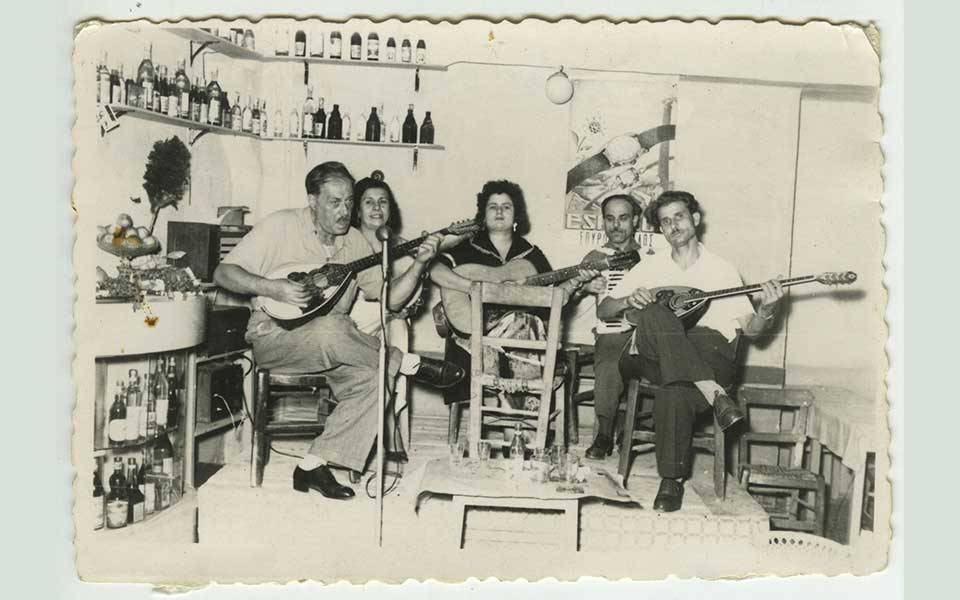
Markos Vamvakaris (bouzouki), on stage in Syros, early 1950s.
© Tasos Schorelis’ archive
What makes Hadjidakis’ remarks on Xenakis more interesting still is Hadjidakis’ connection to rebetiko, the genre of the urban working class with its roots in Asia Minor:
“...What the nation needed at that point was to embrace the humble, as opposed to the obsession with the Great Idea prevalent at the time. Pikionis paved the way to the Acropolis stone by stone. We discovered Karagiozis, and I, driven by the same need, discovered rebetiko.”
It’s surprising connections like these, taking us from the world of Vamvakaris and Tsitsanis to Xenakis in one step, that make the exhibition so gratifying.
Koutsoudaki places the significance of Hadjidakis’ commitment to rebetiko in a broader cultural context: “When he was just 24, and the nation was in the turmoil of Civil war, Hadjidakis addressed an audience at the Theatro Technis in defense of rebetiko, calling it a “genuinely and uniquely Greek art” and inviting to the stage Vamvakaris and Sotiria Bellou. It’s hard for us now to imagine how marginalized rebetiko once was; via Skalkottas and Hadjidakis, rebetiko became somehow legitimized, part of contemporary, middle-class, urban culture.”
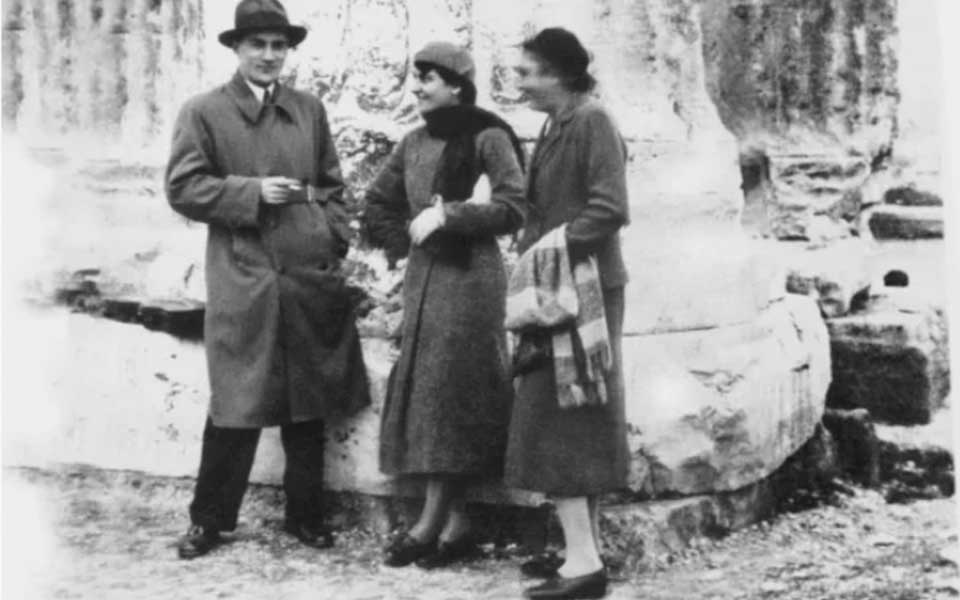
Nikos Skalkottas with choreographers Polyxene Mathey and Koula Pratsika, Athens 1933.
© Polyxene Mathey Archive
Tsitsanis’ bio in the Ghika Gallery relates that, while he was censored during the right-leaning Metaxas regime, he also faced the “abhorrence of the left for rebetiko” at the same time. This was the case for other rebetiko composers and musicians too. Today, rebetiko is a popular genre with the left, not least because of its origin in a marginalized working class. But during the Civil war and its aftermath, passions ran high. Koutsoudaki offers perspective: “The problem was the association of rebetiko with hashish; devoted leftists felt it dulled revolutionary fervor.”
We can see this in the display on Alekos Xenos, which includes a newspaper interview entitled “I accuse Rebetiko.” A quote illustrates his leftist ideology:
“After the discussions about the art of music with Lavrongas and later on with Varvoglis, Kalomiris, Mitropoulos, and Skalkottas, I was convinced that, under the circumstances, in order to communicate with the people we needed an art which would be national in form as well as progressive and socialist in content.”
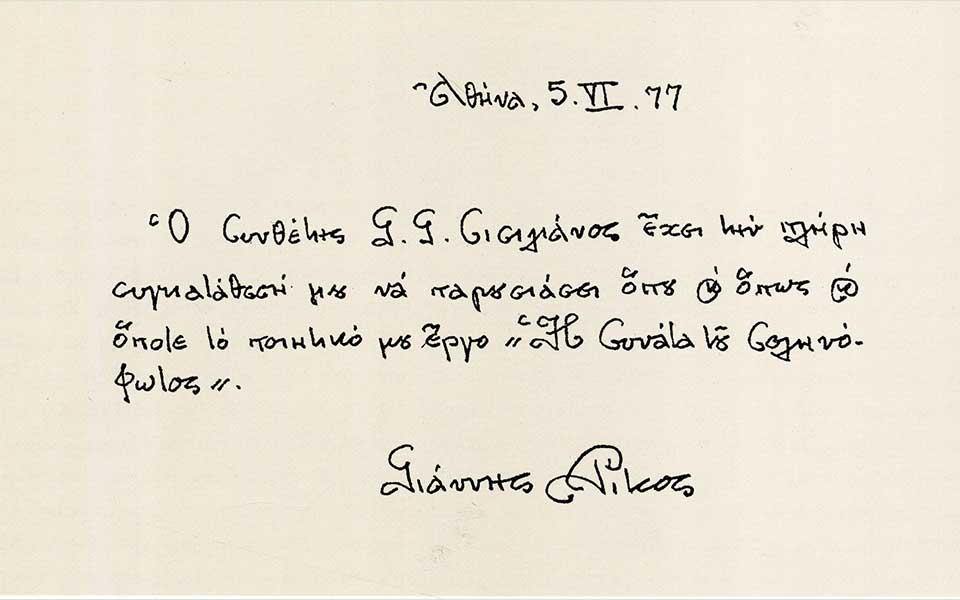
Yannis Ritsos' written permission to to Sicilianos to use his poem Moonlight Sonata for a song.
Works by the friends Hadjidakis and Theodorakis (“a beast of creativity” exclaims Koutsoudaki) are familiar to Greeks and visitors alike. “With most of these guys, but especially Theodorakis and Hadjidakis, we have a possessiveness; we see them as somehow ‘ours’.” The relationship of Greeks to their poets is similarly close. Both composers created interpretations of Ritsos’ work “Epitaphios”; we hear them on the app. Poetry was the cornerstone of inspiration for Theodorakis:
“My biggest ambition is to faithfully serve modern Greek poetry. So much so that when you listen to a song you won’t be able to imagine (that) music covering a different poem, nor the poem set to a different music.”
Theodorakis set several other seminal poems to music, including Seferis’ Denial (prompting Seferis to exclaim: “The semicolon! The semicolon! Or you change what I mean.”) and Elytis’ Axion Esti.
Ritsos’ Lady in the Moonlight was made into a song by Sicilianos, while works by Cavafy, besides inspiring Mitropoulos’ 14 Invenzioni, also inspired Hadjidakis (Magnus Erotas from “Days of 1903”), Theodorakis (The God Abandons Antony), and Papaioannou (The Funeral of Sarpedon). We can hear them on the app beside the portrait of Cavafy (sketched by Tetsis). We also hear Raining in the Poor Neighborhood, composed by Theodorakis with words by the poet Tassos Leivaditis (co-writer of the film A Neighborhood Named the Dream, in which the song appears), and poet Nikos Gatsos’ Kemal, whose version by Hadjidakis will be familiar to many.


A special display is dedicated to The Birds. In 1959, the director Karolos Koun staged a revolutionary production of Aristophanes’ play at the Herodes Atticus Theater. Hadjidakis composed the music, Tsarouchis designed the costumes, and Manou prepared the chorus. Koun’s interpretation redefined the chorus’ role, making it the protagonist.
The performance caused an uproar: “Besides the paper costumes by Tsarouchis, which began to fall apart on the hot August night, this was the true objection,” explains Koutsoudaki, “the revolutionary transformation of the collective – the many – which were perceived as significant enough to be the true protagonist.” An adjacent cartoon depicts Koun and the Minister of Public Administration, Konstantinos Tsatsos, who was so incensed that he tried to have the performance canceled in the middle (he managed to cancel it the next day). This interpretation of The Birds remains a milestone, performed many times. The app includes a video.
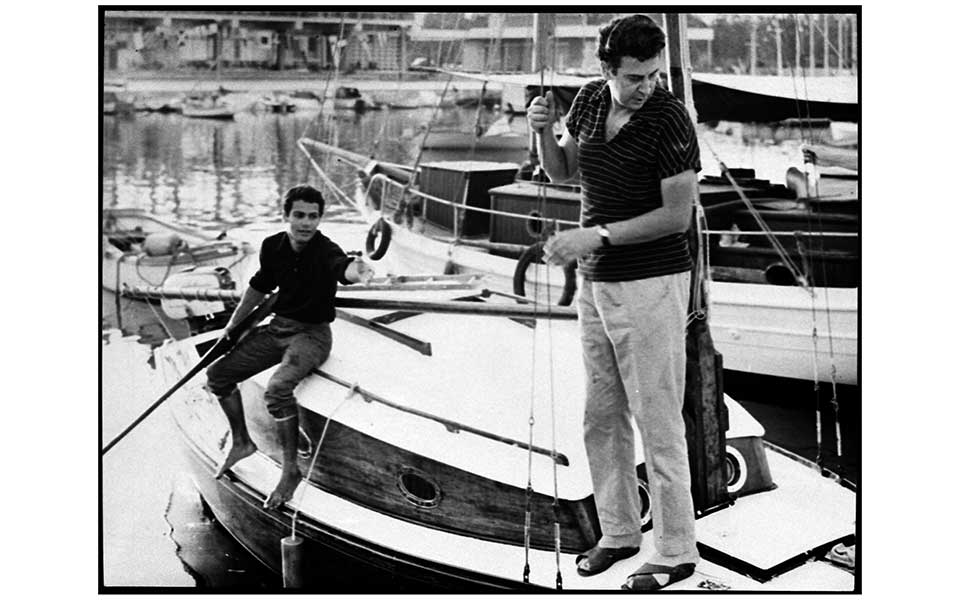
Stavros Xarhakos with Mikis Theodorakis on “Tsoufi”, Theodorakis’ caique, 26 June 1965.
© Mikis Theodorakis’ archive Music Library of Greece “L. Voudouri”
In 1963, Belgian TV produced “Mikis Theodorakis and Greek Popular Music,” part of a series of documentaries, each hosted by a major cultural figure. “He was at his height now; for his symphonic music internationally, and in Greece for his popular music,” says Koutsoudaki. He presents the work of Hadjidakis, Vamvakaris, and Tsitsanis, and also of Dora Stratou and her dance theater, narrating from the Temple of Hephaestus in the Agora as his daughter Margarita runs among the wildflowers.
“For many Greeks, Xarchakos is part of a trinity alongside Hadjidakis and Theodorakis.” Koutsoudaki filmed Xarchakos – a link to the world of the exhibition and a working composer and performer still from his home and studio for the exhibition. Among the moments he relates are when Tsarouchis met him in the street to make a painting of the house he grew up (it was to be torn down, and Tsarouchis loved neoclassical houses), getting to know Melina Mercouri (his mother’s childhood friend), and his encounters with Leonard Bernstein and David Diamond. He shares the room we see on a panoramic screen with album covers (including Tsarouchis’ painting of his house), correspondence, and other exhibits he lent for this installation.
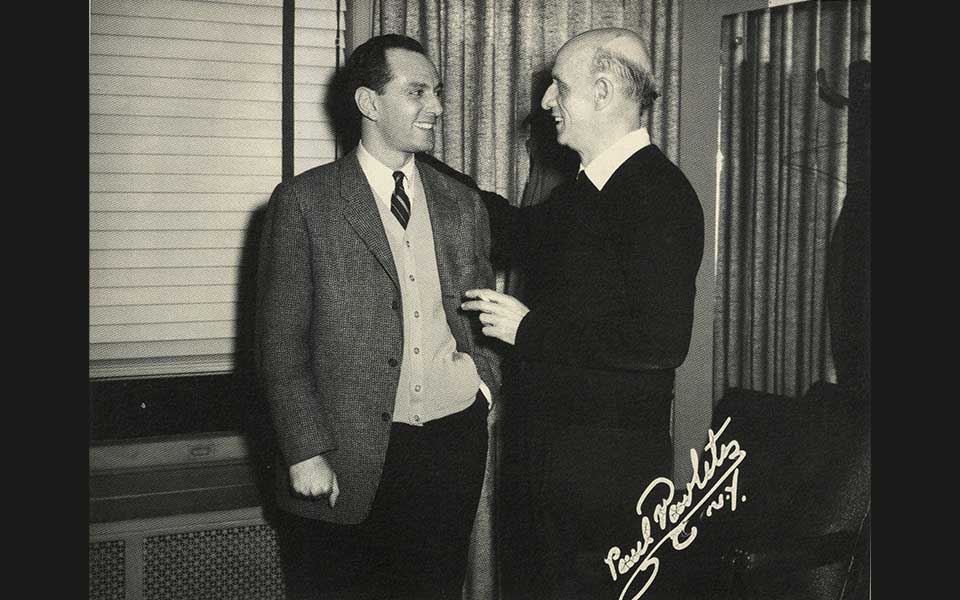
Yorgos Sicilianos with Dimitris Mitropoulos in New York, probably in 1958.
Why the title? For one thing, it’s true; it’s definitely time we listened. The title is The Show is Greek, a book by Menis Koumoundareas; he recalls how the hostess Eleni Ourani invited Mitropoulos to the piano with the words “I think it’s time we listened…”.
This is an illuminating introduction to the music of 20th-century Greece in its span of genres, from rebetiko and folk music to the adoption of the experimental structures of the avant-garde, such as serialism and the 12-tone system. We see the composers’ commitment to Greek culture as a whole through the strong connection to poetry, and the frequent collaborations with fine artists (such as the influential cover Moralis did for “Six Folk Drawings”) and the dramatic arts. We also see Greek music in an international context – Mitropoulos in New York, Xenakis in Paris with Messaien, Skalkottas in Berlin with Kurt Weill and Arnold Schoenberg, Sicilianos in the USA with Darius Milhaud.
Most of all, the exhibition draws us closer to the story. It strengthens our affection for our own favorites as we get to know them better, while introducing us to composers we might not have known so well but may now grow to love.
“I think it’s time we listened…” is presented by the Institute of Greek Music Heritage and curated by architect and museologist Erato Koutsoudaki, with valuable assistance from the musicologists of the Friends of Music Society
The exhibition has been funded by the Qualco Group
The Ghika Gallery of the Benaki Museum, 3 Kriezotou, Tel. (+30) 210.361.5702, 210.363.0818
Thursdays 10:00-22:00. Fridays, Saturdays, and Sundays, 10:00-18:00
The exhibition will be on until 21.07.2024
From bustling street markets to Hydra’s...
From sculpture to silent movement, explore...
From fishermen’s chants to moonlit serenades,...
The Olympic elite, Hollywood’s finest, the...